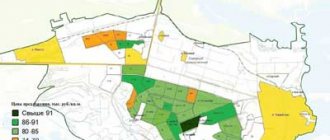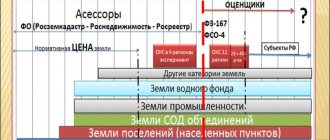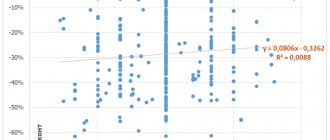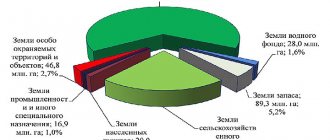Interesting and attractive, from the point of view of investing in the non-productive sphere, are such real estate market objects as land plots. This interest in them can be explained by three key characteristics, which will be discussed below.
The issue of land as a real estate object is multifaceted and broad, but first we will try to understand the general concept and touch on the basic methods of land valuation, which any novice investor working in the real estate market needs to know.
METHODOLOGICAL RECOMMENDATIONS FOR DETERMINING THE MARKET VALUE OF LAND
I. General provisions
These methodological recommendations for determining the market value of land plots were developed by the Ministry of Property of Russia in accordance with Decree of the Government of the Russian Federation dated July 6, 2001 No. 519 “On approval of valuation standards.”
Methodological recommendations can be used to evaluate land plots (valuation objects) that have not been withdrawn from circulation, which are formed (or can be formed) in accordance with the law. (hereinafter referred to as land plots)
Purposes and types of land valuation
The purposes of land valuation may vary. Since a significant part of land is involved in civil circulation and is a commodity (while still remaining an important natural resource), for the full functioning of the land market, as mentioned above, an assessment of the market value of land, i.e., a monetary valuation of land, is vital. For example, when determining the price for a purchase and sale transaction of a plot.
According to the Land Code of the Russian Federation, payment for the use of land is one of the basic principles of land legislation. The principle of payment is intended to stimulate the rational use, protection and development of land, increase soil fertility, and help level out the socio-economic conditions of management. The main way to implement it is taxation. And in order to calculate the amount of land tax, a universal basic indicator is needed, which is currently established for the cadastral valuation of land (land plots) in the Russian Federation. Therefore, the tax burden as payment for land and land valuation are closely related. According to Federal Law No. 137-FZ of October 25, 2001, in cases where the cadastral value of land is not determined, for the purposes specified in Article 65 of the Land Code of the Russian Federation, the normative price of land is applied.
The normative assessment of land gives reason to recall the Law of the RSFSR of October 11, 1991 No. 1738-1 “On payment for land”. Since January 1, 2004, this law has been declared repealed with the exception of Article 25, which talks about the standard price of land: “The standard price of land is an indicator characterizing the cost of a plot of a certain quality and location, based on the potential income for the estimated payback period.”
The state cadastral valuation of land is carried out in accordance with the Rules for the state cadastral valuation of land, approved by Decree of the Government of the Russian Federation of April 8, 2000 No. 316.
Mandatory for use when determining the cadastral value of land plots, information about which is contained in the state real estate cadastre on the date of assessment, is the Federal Valuation Standard “Determination of Cadastral Value (FSO No. 4)”, approved by the Order of the Ministry of Economic Development of the Russian Federation of October 22, 2010. No. 508.
State land assessment is carried out to determine the cadastral value of land plots for various purposes at least once every five years.
The results of the state cadastral valuation of land are approved by the executive authorities of the constituent entities of the Russian Federation on the proposal of the territorial bodies of the Federal Real Estate Cadastre Agency. The results of the cadastral valuation of land are entered into the state land cadastre.
Cadastral valuation of land is based on the classification of land according to its intended purpose and type of functional use.
The state cadastral assessment of land takes into account data from land, urban planning, forestry, water and other cadastres.
Knowing the cost of land is necessary in a number of other cases. In particular:
- when transferring a plot for rent or collateral;
- lending;
- insurance;
- contribution to the authorized (share) capital;
- making management decisions;
- preparation of financial (accounting) statements;
- withdrawal for state needs;
- determining the value of the debtor's property during bankruptcy proceedings;
- determining the value of property received free of charge;
- resolution of property disputes.
II. Methodological basis for assessing the market value of land plots
Market value is given to those land plots that are capable of satisfying the needs of the user (potential user) for a certain time (the principle of utility).
The market value of a land plot depends on supply and demand in the market and the nature of competition between sellers and buyers (the principle of supply and demand).
The market value of a land plot cannot exceed the most probable costs of acquiring an object of equivalent utility (substitution principle).
The market value of a land plot depends on the expected value, duration and probability of receiving income from the land plot over a certain period of time with its most effective use, without taking into account income from other factors of production attracted to the land plot for business activities (hereinafter, for the purposes of these recommendations, land rent ) (expectation principle).
The market value of a land plot changes over time and is determined on a specific date (principle of change).
The market value of a land plot depends on changes in its intended purpose, permitted use, the rights of other persons to the land plot, and the division of property rights to the land plot.
The market value of a land plot depends on its location and the influence of external factors (the principle of external influence).
The market value of a land plot is determined based on its most effective use, that is, the most likely use of the land plot, which is physically possible, economically justified, meets legal requirements, is financially feasible and as a result of which the estimated value of the land plot will be maximum (the principle of the most effective use) . The most effective use of a land plot is determined taking into account its possible justified division into separate parts that differ in shape, type and nature of use. The best use may not be the current use of the land.
When determining the most effective use, the following are taken into account:
intended purpose and permitted use; the prevailing land use methods in the immediate vicinity of the assessed land plot; prospects for the development of the area in which the land plot is located; expected changes in the land and other real estate market; current use of the land.
III. General guidelines for conducting assessments
It is recommended to assess the market value of land plots in accordance with the methodological principles given above.
The date of assessing the value of a land plot, as a rule, should not be later than the date of its last inspection by the appraiser.
When making an assessment, the appraiser is obliged to use information that ensures the reliability of the assessment report as a document containing information of evidentiary value. The volume of information used in the assessment, the choice of sources of information and the procedure for using information are determined by the appraiser.
The results of the assessment must be documented in a written assessment report.
The appraisal report may contain appendices, the composition of which is determined by the appraiser, taking into account the requirements stipulated by the terms of the appraisal agreement.
All materials in the assessment report must be aimed at justifying the market value of the land plot. The inclusion in the appraisal report of materials and information not related to the determination of market value should be avoided.
It is recommended to include in the report on the assessment of the market value of a land plot:
description of the land plot, including the intended purpose and permitted use of the land plot, the rights of other persons to the land plot, division of property rights to the land plot; description of buildings, structures, structures, engineering infrastructure facilities located within the land plot, as well as the results of work and anthropogenic impacts that change the qualitative characteristics of the land plot (hereinafter referred to as land plot improvements); photographs of the land and its improvements; characterization of the state of the land and real estate market; establishing the option for the most effective use of the land plot.
The final value of the market value of a land plot must be expressed in rubles as a single value, unless otherwise provided in the valuation agreement (for example, the valuation agreement may stipulate that the final value of the land plot is expressed as a range of values).
Why do land plots attract investors?
Three key characteristics of land plots that distinguish them from other objects (buildings, structures, etc.):
- firstly , land can be confidently called the basis or basis of any other type of real estate;
- secondly , land plots as a resource have wide possibilities - they can be sold for construction, used for personal purposes, for business development or to receive a stable income from renting them out;
- thirdly , they do not require high maintenance and service costs.
Attention! Land is one of the most reliable investment objects in the real estate market, plus the best protection of investment capital from inflation.
Having highlighted the key advantages, we move on to the main concept. It is necessary to separate the concept of land and land plots. Still, land is a more general concept, so when talking about investments in real estate, it would be most correct to use the concept of land plots.
In the Land Code of the Russian Federation, the concept of a land plot is interpreted as follows:
- it is an object of land relations and property rights;
- it is an immovable thing (real estate);
- it is a part of the earth's surface with characteristics that allow it to be defined as an individual thing.
Thus, land plots can be confidently called a territory that is ready to be used for various purposes, including investment.
IV. Assessment methods
When conducting an assessment, the appraiser is obliged to use (or justify the refusal to use) cost, comparative and income approaches to assessment. The appraiser has the right to independently determine specific assessment methods within each assessment approach. This takes into account the volume and reliability of market information available for use of a particular method.
As a rule, when assessing the market value of land plots, the sales comparison method, the allocation method, the distribution method, the land rent capitalization method, the residual method, and the intended use method are used.
The comparative approach is based on the sales comparison method, the allocation method, and the distribution method. The income approach is based on the method of capitalization of ground rent, the residual method, and the method of intended use. Elements of the cost approach in terms of calculating the cost of reproduction or replacement of land improvements are used in the residual method and the allocation method.
The following is the content of the listed methods in relation to assessing the market value of land plots occupied by buildings, structures, structures or intended for their placement, as well as the features of assessing the market value of agricultural land.
If other methods are used in the assessment report, it is advisable to disclose their content and justify their use.
Cadastral valuation of lands in settlements
The Methodological Guidelines for the state cadastral valuation of land in populated areas, approved by Order of the Ministry of Economic Development and Trade of the Russian Federation dated February 15, 2007 No. 39, help determine the cadastral value of land plots with different types of permitted use on the lands of settlements.
Carrying out a cadastral valuation of land in settlements consists of two stages: creating a list of land plots and calculating their cadastral value.
State cadastral valuation of urban lands, rural settlements, horticultural, gardening and dacha associations is carried out on the basis of statistical analysis of market prices and other information about real estate, as well as other methods of mass real estate valuation.
Cadastral valuation of agricultural land
The state cadastral assessment of agricultural lands outside the boundaries of urban and rural settlements and with the exception of areas located within the boundaries of horticultural, gardening and dacha associations, as well as the assessment of forest lands (forest fund lands), is carried out on the basis of capitalization of estimated rental income.
Order No. 445 of the Ministry of Economic Development of the Russian Federation dated September 20, 2010 approved the Methodological Guidelines for the state cadastral valuation of agricultural land.
The assessment is carried out in three stages:
- formation of a list of land plots;
- determination of specific indicators of their cadastral value;
- cost calculation.
The list of sites is compiled by the regional department of the Federal Service for State Registration, Cadastre and Cartography (Rosreestr) as of January 1 of the year of work. It must contain information about all lands located in the assessed territory.
Specific indicators of land plots depend on the type of their use.
Determining the specific indicators of the cadastral value of land involves, among other things, calculating the costs per unit area for maintaining soil fertility for each crop rotation.
The cadastral value is calculated by summing the products of specific indicators and areas occupied by these lands within the boundaries of the site.
The cadastral value of land plots as part of agricultural land is determined as of January 1 of the year of work on the state cadastral valuation of agricultural land on the territory of a constituent entity of the Russian Federation.
The concept of “economic valuation of land” was provided for in the regulatory documents of the pre-reform period. This assessment of the condition of the land served to determine the comparative value of plots of land as a means of production in agriculture. Its indicators depended on the natural (or artificial) fertility and natural and economic conditions of the area where the land plots were located.
Sales comparison method
The method is used to evaluate land plots, both occupied by buildings, structures and (or) structures (hereinafter - developed land plots), and land plots not occupied by buildings, structures and (or) structures (hereinafter - undeveloped land plots). The condition for applying the method is the availability of information on the prices of transactions with land plots that are analogues of the property being valued. In the absence of information on the prices of transactions with land plots, it is allowed to use supply (demand) prices.
The method involves the following sequence of actions:
determination of the elements by which the evaluation object is compared with analogous objects (hereinafter referred to as comparison elements); determination for each element of comparison of the nature and degree of differences between each analogue and the land plot being assessed; determination for each of the comparison elements of price adjustments of analogues corresponding to the nature and degree of differences of each analogue from the assessed land plot; adjustment for each element of price comparison of each analogue, smoothing out their differences from the assessed land plot; calculation of the market value of a land plot through a reasonable generalization of adjusted prices of analogues.
The elements of comparison include the factors of value of the property being assessed (factors whose changes affect the market value of the property being assessed) and the characteristics of transactions with land plots that have developed in the market.
The most important cost factors tend to be:
location and environment; intended purpose, permitted use, rights of other persons to the land plot; physical characteristics (relief, area, configuration, etc.); transport accessibility; infrastructure (presence or proximity of utility networks and conditions for connecting to them, social infrastructure facilities, etc.).
The characteristics of land transactions include, among other things:
conditions for financing transactions with land plots (ratio of own and borrowed funds, conditions for the provision of borrowed funds); terms of payment when making transactions with land plots (payment in cash, settlement by bills, offsets, barter, etc.); circumstances of the transaction with land plots (whether the land plot was presented to the open market in the form of a public offer, affiliation of the buyer and seller, sale under bankruptcy conditions, etc.); changes in prices for land plots for the period from the date of conclusion of a transaction with an analogue to the date of assessment.
The nature and degree of differences between the analogue and the assessed land plot are established in the context of the elements of comparison by direct comparison of each analogue with the object of assessment. In this case, it is assumed that the transaction with the object of assessment will be made based on the characteristics of transactions with land plots that have developed in the market.
Adjustments to the prices of analogues by comparison elements can be determined both for the price of a unit of measurement of the analogue (for example, a hectare, square meter) and for the price of the analogue as a whole. Price adjustments can be calculated in monetary or percentage terms.
The magnitude of price adjustments is typically determined in the following ways:
direct pairwise comparison of prices of analogues that differ from each other only in one element of comparison, and determination, based on the information thus obtained, of adjustments for this element of comparison; direct pairwise comparison of the income of two analogues, differing from each other only in one element of comparison, and determining, by capitalizing the difference in income, adjustments for this element of comparison; correlation and regression analysis of the connection between changes in the comparison element and changes in prices of analogues (prices of units of measurement of analogues) and determination of the equation for the relationship between the value of the comparison element and the market value of the land plot; determining the costs associated with changing the characteristics of a comparison element in which the analogue differs from the object of evaluation; expert substantiation of analogue price adjustments.
As a result of determining and making adjustments, prices of analogues (units of measurement of analogues), as a rule, should be close to each other. In case of significant differences in the adjusted prices of analogues, it is advisable to choose other analogues; elements for which comparison is made; adjustment values.
Selection method
The method is used to evaluate built-up land plots.
Conditions for using the method:
availability of information on the prices of transactions with single real estate objects, similar to a single real estate object, which includes the land plot being assessed. In the absence of information on transaction prices, it is permissible to use supply (demand) prices; correspondence of land improvements to its most effective use.
The method involves the following sequence of actions:
determination of the elements by which a single real estate object, including the assessed land plot, is compared with analogous objects; determination for each of the elements of comparison of the nature and degree of differences of each analogue from a single real estate object, including the assessed land plot; determination for each of the comparison elements of price adjustments of analogues, corresponding to the nature and degree of differences of each analogue from a single real estate object, including the land plot being assessed; adjustment for each of the elements of price comparison for each analogue, smoothing out their differences from a single real estate object, which includes the land plot being assessed; calculation of the market value of a single property, including the assessed land plot, by means of a reasonable generalization of the adjusted prices of analogues; calculation of the replacement cost or cost of reproduction of improvements to the assessed land plot; calculation of the market value of the assessed land plot by subtracting from the market value of a single real estate object, including the assessed land plot, the cost of replacement or the cost of reproduction of improvements to the land plot.
The amount of costs for creating improvements to a land plot can be determined using aggregated and (or) elemental cost indicators.
Integrated cost indicators include both indicators characterizing the parameters of the object as a whole - square, cubic, linear meter, and indicators for complexes and types of work.
Elemental cost indicators include elemental prices and rates used in determining the amount of costs for creating improvements.
Aggregated and elemental cost indicators calculated at the price level fixed for a specific date (basic price level) can be recalculated into the price level as of the valuation date using a system of current and forecast indices of changes in construction costs.
Calculation of the amount of costs for creating improvements using elemental cost indicators can also be carried out using resource and resource-index methods. Resource (resource-index) methods consist of calculating in current (forecast) prices and tariffs all resources (cost elements) necessary to create improvements.
When determining the amount of costs for creating improvements to a land plot, one should take into account the investor’s profit - the amount of the most likely reward for investing capital in creating improvements. The investor's profit can be calculated as the difference between the sale price and the costs of creating similar objects. The investor's profit can also be calculated as the return on capital for his most likely investment with a similar level of risk.
When determining replacement cost or reproduction cost, the amount of accumulated depreciation of improvements is taken into account.
Accumulated depreciation of improvements may be determined in total or in monetary terms as the sum of the physical, functional, and portion of economic depreciation attributable to the improvements.
Physical depreciation is the loss of value of improvements due to deterioration of their physical properties.
Functional wear and tear is the loss of value of improvements due to the inconsistency of the space-planning solution, building materials and engineering equipment of improvements, the quality of construction work performed or other characteristics of improvements with modern market requirements for this type of improvement.
Economic depreciation is the loss of value of a single property caused by the negative impact of factors external to it.
Physical and functional wear and tear can be removable or irreparable. Economic wear and tear is usually irreparable. In this case, wear and tear is removable if the cost of its elimination is less than the increase in the value of the property as a result of its elimination.
Tatarova A.V. Real estate valuation and property management
Training manual. Taganrog: TRTU Publishing House, 2003.
| Previous | Table of contents | Next |
2. Real estate valuation
2.7. Land valuation methods
Normative method
is to determine the standard price of land. It is used when transferring, purchasing land into ownership, establishing common joint (shared) ownership in excess of the free norm, transferring by inheritance or donation, obtaining a secured loan, withdrawal for state or public needs.
Urban lands are assessed taking into account the density of development, the prestige of the area, the nature of the surrounding land use, environmental conditions, engineering and transport facilities, etc. The lands are divided into zones differentiated by the basic rates of land tax and the standard price of land (Law of the Russian Federation “On Payment for Land”) . The standard price of land is fixed in the Land Cadastre.
The basis for determining the standard price of land: land tax rates and increasing coefficients, land tax benefits are not taken into account.
It is often necessary to evaluate an object consisting of a building and a land plot, when the latter has only lease rights. In this case, the cost of allocating a land plot for construction can be taken into account as the cost of land.
In market conditions, if the necessary information is available, it is advisable to use methods based on the analysis of market data. The Order of the Ministry of Property of Russia dated March 7, 2002 No. 568-r approved the Methodological Recommendations for determining the market value of land plots. As a rule, when assessing the market value of land plots, the sales comparison method, the allocation method, the land rent capitalization method, the distribution method, the residual method, and the method of dividing into plots are used.
Sales comparison method
is the simplest and most effective valuation method, can be used to evaluate both actually vacant and supposedly vacant land; allows you to determine the specific price of a land plot by making percentage adjustments to the sales prices of analogues. In the absence of information on the prices of transactions with land plots, it is allowed to use supply (demand) prices.
Commonly accepted comparison elements for land plots: ownership, financing conditions, special conditions of sale, market conditions (change over time), location (distance from the city and roads, environmental characteristics), zoning conditions, physical characteristics (size, shape and depth of the plot, angular location, soil type, topography), available utilities, economic characteristics, best and most efficient use. When valuing land, you can use multiple units of comparison, adjusting the price of each and ending up with multiple values that define a range of values. Urban lands represent a special category; their value is influenced by the size of the city and its production and economic potential, the level of development of engineering and social infrastructure, regional natural, environmental and other factors.
The method gives fairly accurate results only in a developed information-open competitive market. The Russian land market does not meet these requirements; the value of a land plot cannot be determined based on information about sales transactions of analogue plots. Therefore, the assessment must collect all available information to apply all site assessment methods.
Ground rent capitalization method
is based on the fact that if there is sufficient information on rental rates for land plots, it is possible to determine the value of these plots as the current value of future income in the form of rent for the land plot being assessed. Within the framework of this method, the value of land rent can be calculated as income from leasing a land plot under the conditions prevailing in the land market. As a regular income stream, land rents can be capitalized into value by dividing by the land capitalization rate determined from market analysis. The initial data for capitalization is obtained from a comparison of sales of leased land and rental values.
Based on the rental rate received, the market value of the site is determined using the income approach, usually using the direct capitalization method. The formula for calculating the cost of a land plot has the form
,
where VL is the cost of the land plot,
IL – income from land ownership,
RL: – capitalization rate for land.
The capitalization rate is determined by dividing the value of ground rent for similar land plots by their sale price or by increasing the risk-free rate of return on capital by the amount of the risk premium associated with investing capital in the land plot being assessed.
The main factors influencing the rental rate of a land plot: location characteristics, size, shape, surrounding type of land use, transport accessibility, engineering equipment.
However, in Russia, state and municipal lands are mainly leased, and the rent is calculated in accordance with the standard price of land, which is not equivalent to its market value. Currently, attempts are being made to lease land at its market value, but it is too early to talk about the objectivity of the results of the practical application of the land rent capitalization method.
Distribution method
(method of ratio, correlation,
allocation ) -
determination of the component of the cost of a land plot based on the known ratio of the cost of land and improvements in the property complex. The method is based on the principle of contribution and the assertion that for each type of property there is a normal relationship between the value of land and buildings. This ratio is most reliable for new buildings; they are close to the best and most efficient use option. The older the buildings, the greater the ratio of land value to total property value.
To apply the method, reliable statistical data is required on the relationship between the values of land and all property of a particular type of real estate in a given market. However, the method is rarely used even in developed markets, as it has low reliability. The use of the method is justified in conditions of insufficient information on land sales. The resulting values are considered approximate.
Isolation (extraction) method
is used to evaluate built-up land plots if there is information on transaction prices for similar real estate objects. Improvements to the land correspond to its most efficient use. The method involves the following sequence of actions:
– determination of elements for comparison of objects; – determination of the differences between each analogue and the object of evaluation; – calculation and making adjustments for each of the comparison elements; – calculation of the market value of a single property, including the land plot being assessed, by means of a reasonable generalization of the adjusted prices of analogues; – calculation of the replacement cost or cost of reproduction of improvements to the assessed land plot; – calculation of the market value of the assessed land plot by subtracting from the market value of a single real estate object, including the assessed land plot, the cost of replacement or the cost of reproduction of improvements to the land plot.
The allocation method is used when the contribution of improvements to the total price of the plot is small, it is recommended for evaluating suburban areas (for which the contribution of improvements is small and is quite easily determined), and is used in the absence of data on sales of land in the surrounding area.
The method is most effective in a passive market (there is no data on the sale of vacant land plots), taking into account the characteristics of the initial information and the model for obtaining the desired value. The cost of a land plot in general is determined by the formula
,
where Сз is the cost of the land plot,
C – cost of the object,
Su – cost of improvements.
Remainder method
is based on the investment group's technique for physical components. The method is used to evaluate built-up and undeveloped plots, if it is possible to develop the assessed land plot with income-generating improvements. The value of land is determined by capitalizing the portion of income attributable to the land.
To determine the value of a plot of land, it is necessary to know the cost of the building, the net operating income of the entire property, and the capitalization rates for the land and for the buildings.
The main steps of the residual method for land:
1) the net operating income of the entire property is determined based on market rent and estimated operating expenses;
2) the net operating income related to the structure (building) is determined;
3) net operating income attributable to the land plot is capitalized into the value indicator through the capitalization rate for the land.
It is difficult to predict income in conditions of insufficient economic stability.
Subdivision method
(development approach) is used in assessing land suitable for subdivision into individual plots. Consists of the following steps:
– determination of the size and number of individual plots; – calculation of the cost of developed plots using the comparable sales comparison method; – calculation of costs and development schedule, expected period of sale and reasonable business profit; – deduction of all development costs and business profits from the estimated total sale price of the plots to determine the net proceeds from the sale of real estate after completion of development and sale of individual plots; – selection of a discount rate that reflects the risk associated with the period of expected development and sale.
Land development costs usually include:
– expenses for laying out, clearing and grading sites; – expenses for the construction of roads, sidewalks, utility networks, drainage; – taxes, insurance, engineering fees; – marketing expenses; – profit and overhead costs of the contractor, etc.
In general, modeling the market value of land plots is carried out within the framework of the assumption that dynamic equilibrium has been achieved in the competition of various “rational” land users for the right to occupy a certain plot. With the balance of effective demand and supply on the simulated land market and limited supply, the issue of the most effective use of the site as free and taking into account the existing development is resolved. Modeling of potential rental income for various types of land use is based on the patterns of formation of rental effects of location and prevailing prices (sales and rentals). Considering the significant difference in cost indicators for plots located along the front of the city’s road network and located in intra-block areas, these plots are subject to mandatory division during assessment. The implementation of the principle of the most effective use occurs in conditions of competition for the use of real estate between various functional segments of the market, taking into account real restrictions on the volume of demand and the possible multifunctionality of the territory, as a result of which a set of land users is formed on each site.
| Previous | Table of contents | Next |
Distribution method
The method is used to evaluate built-up land plots.
Conditions for using the method:
availability of information on the prices of transactions with single real estate objects, similar to a single real estate object, which includes the land plot being assessed. In the absence of information on transaction prices, it is permissible to use supply (demand) prices; availability of information on the most probable share of a land plot in the market value of a single property; correspondence of land improvements to its most effective use.
The method involves the following sequence of actions:
determination of the elements by which a single real estate object, including the assessed land plot, is compared with analogous objects; determination for each of the elements of comparison of the nature and degree of differences of each analogue from a single real estate object, including the assessed land plot; determination for each of the comparison elements of price adjustments of analogues, corresponding to the nature and degree of differences of each analogue from a single real estate object, including the land plot being assessed; adjustment for each of the elements of price comparison for each analogue, smoothing out their differences from a single real estate object, which includes the land plot being assessed; calculation of the market value of a single property, including the assessed land plot, by means of a reasonable generalization of the adjusted prices of analogues; calculation of the market value of the assessed land plot by multiplying the market value of a single real estate object, which includes the assessed land plot, by the most probable value of the share of the land plot in the market value of a single real estate object.
Ground rent capitalization method
The method is used to evaluate built-up and undeveloped land plots. The condition for applying the method is the possibility of obtaining land rent from the land plot being assessed.
The method involves the following sequence of actions:
calculation of land rent created by a land plot; determining the value of the corresponding land rent capitalization coefficient; calculation of the market value of a land plot by capitalizing land rent.
Capitalization of ground rent is understood as the determination, on the date of the valuation, of all future values of ground rent that are equal to each other or changing at the same rate for equal periods of time. The calculation is made by dividing the value of land rent for the first period after the date of assessment by the corresponding capitalization coefficient determined by the appraiser.
Within the framework of this method, the value of land rent can be calculated as income from leasing a land plot under the conditions prevailing in the land market.
The main ways to determine the capitalization ratio are:
dividing the value of land rent for similar land plots by their selling price; an increase in the risk-free rate of return on capital by the amount of the premium for the risk associated with investing capital in the assessed land plot.
In this case, the risk-free rate of return on capital is understood as the rate of return for the least risky investment of capital (for example, the rate of return on deposits of banks of the highest category of reliability or the rate of return to maturity on government securities).
Remainder method
The method is used to evaluate built-up and undeveloped land plots. The condition for applying the method is the possibility of developing the assessed land plot with improvements that generate income.
The method involves the following sequence of actions:
calculation of the cost of reproduction or replacement of improvements corresponding to the most efficient use of the assessed land plot; calculation of net operating income from a single property for a certain period of time based on market rental rates; calculation of net operating income attributable to improvements for a certain period of time as the product of the cost of reproduction or replacement of improvements by the corresponding capitalization ratio of income from improvements; calculation of the amount of ground rent as the difference between the net operating income from a single property for a certain period of time and the net operating income attributable to improvements for the corresponding period of time; calculation of the market value of a land plot by capitalizing land rent.
The method also allows the following sequence of actions:
calculation of the cost of reproduction or replacement of improvements corresponding to the most efficient use of the assessed land plot; calculation of net operating income from a single property for a certain period of time based on market rental rates; calculating the market value of a single property by capitalizing net operating income for a certain period of time; calculating the market value of a land plot by subtracting the cost of reproduction or replacement of improvements from the market value of a single piece of real estate.
Net operating income is equal to the difference between actual gross income and operating expenses. In this case, only those operating expenses that, as a rule, are borne by the lessor are deducted from the actual gross income.
Actual gross income is equal to the difference between potential gross income and losses from idle premises and losses from non-payment of rent.
Potential gross income is equal to the income that can be received from renting out the entire area of a single real estate property in the absence of losses from non-payment of rent. When assessing a land plot, rental rates for the use of a single property are calculated on the basis of market rental rates (the most probable rental rates at which the property being assessed can be leased on the open market in a competitive environment, when the parties to the transaction act reasonably, having all the necessary information, and the rental rate does not reflect any extraordinary circumstances).
For premises that are empty and used by the owner for his own needs, market rental rates are also used. Potential income includes other income derived from permanent improvements to the property but is not included in the rent.
The amount of operating expenses is determined based on market conditions for leasing single real estate objects. Operating expenses are divided into: constant - independent of the occupancy level of a single property, variable - dependent on the occupancy level of a single property and costs for replacing elements of improvements with a useful life less than the period of use of the improvements as a whole (hereinafter referred to as elements with a short useful life) . Operating expenses do not include depreciation charges on real estate and expenses for servicing debt obligations on real estate.
The cost of replacing improvement elements with a short lifespan is calculated by dividing the amount of costs for creating these improvement elements by the period of their use. In the process of performing these calculations, it is advisable to take into account the possibility of a percentage increase in funds to replace elements with a short service life.
Management expenses are included in operating expenses regardless of whether the property is managed by the owner or the manager.
When calculating the capitalization rate for land improvements, you should take into account the most likely rate of change in income from the improvements and the most likely change in the value of the improvements (for example, if the cost of improvements decreases, take into account the return on capital invested in the improvements).
Purpose and methods of implementation
Appraisal is meant to determine the price of something. Accordingly, the valuation of a plot of land is the process of determining the value of a land property on the market. Many have encountered the sale, purchase, and rental of land, since it is very multifunctional for running their own business.
The assessment is often used to determine the borrower’s creditworthiness (when applying for a mortgage), when entering into an inheritance, to attract investments, when dividing property, for accounting, etc.
There are three types of land valuation:
- Monetary. Used to determine the land tax rate and when concluding contracts; in turn, there are two types of monetary valuation: normative and monetary;
- Economic. Used to determine the suitability of land for growing a certain crop, when analyzing the most rational use of land; taken into account when conducting a regulatory assessment of the object;
- Soil grading. It is part of the land cadastre and is the basis for economic assessment in the field of agriculture; used to determine soil suitability and also to predict losses in agriculture and forestry.
There are three types of land value : market, cadastral and regulatory.
Market value is the most possible price at which an appraised property can be presented on the open market. In this case, the two parties to the transaction have all the necessary information and emergency circumstances do not affect the price.
If the assessment does not establish a certain type of value of the object, then the market price is established.
The cadastral price is used for tax purposes. This type of cost is set as a percentage of the market value.
Standard – initial, fixed cost established by the state in its own interests. It is used when purchasing land into private ownership, when entering into an inheritance or when transferring it, etc. The standard cost is established annually by the government of the Russian Federation.
The regional standard price may be changed by the government of the Russian Federation depending on the characteristics of the soil and the object itself, but the price should not be more than 75% of the market value. It can be changed by local authorities in the corresponding region, but not more than 25% of that established by the state.
Intended Use Method
The method is used to evaluate built-up and undeveloped land plots.
The condition for applying the method is the possibility of using the land in a way that generates income.
The method involves the following sequence of actions:
determination of the amount and time structure of expenses necessary for the use of a land plot in accordance with its most effective use option (for example, the costs of creating improvements to a land plot or the costs of dividing a land plot into separate parts that differ in shape, type and nature of use); determining the amount and time structure of income from the most efficient use of the land; determining the amount and time structure of operating expenses necessary to generate income from the most efficient use of the land; determining the value of the discount rate corresponding to the level of risk of investing capital in the assessed land plot; calculating the value of a land plot by discounting all income and expenses associated with the use of the land plot.
In this case, discounting is understood as the process of bringing all future income and expenses to the date of assessment at a discount rate determined by the appraiser.
To bring all future income and expenses to the date of assessment, discount rates are used, obtained based on an analysis of the rates of return on capital of investments with similar risk levels.
The source of income can be the rental, economic use of a land plot or a single piece of real estate, or the sale of a land plot or a single piece of real estate in the most likely time frame at market value.
Calculation of income in the option of renting out real estate should include taking into account income from the sale of a single property at the end of the forecast period.








